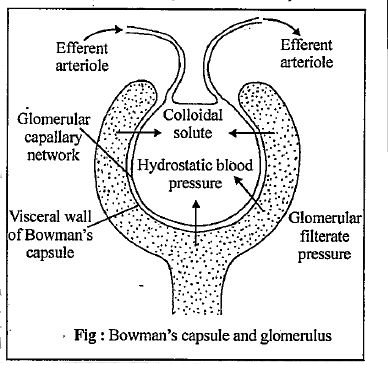Describe the formation of urine in Nephron.
Text Solution
Physiology of urine formation : Urine formation takes place in the kidney. It involves the following steps : I) Glomerular filtration II) Tubular reabsorption III) Tubular secretion
I) Glomerular filteration (ultrafiltration) : The walls of glomerulus and Bowman.s capsule are thin semipermeable membrane. The glomerular capillaries are narrower than the afferent renal arterioles. Therefore, the blood pressure in glomerular capillaries become high. Due to high pressure, the process of ultrafiltration is continuous. Water and many dissolved substances are filtered from blood in lumen of the Bowman.s capsule. The glomerular filtrate contains large amount of water and dissolved substances. These substances are urea, uric acid, creatinine, amino acids, glucose, sodium, potassium etc. The glomerular filtrate and blood plasma are similar except that glomerular filtrate does not have proteins and fats.
II) Tubular Reabsorption : Glomerular filtrate undergoes reabsorption in different parts of the nephron.
i) Proximal convoluted tubule Reabsorption : Proximal convoluted tubule is lined by cuboidal epithelium. This epithelia contain number of mitochondria and also have microvilli. This will increase the reabsorption. In PCT, capallary reabsorption takes place by two ways-active transportation and pressure back diffusion.
a) Active transportation : In active transportation, absorption takes place against the concentration gradient.
b) Back diffusion: Back diffusion is due to low concentration. There is no use of energy, 70% -75% substances are reabsorbed here. Glucose, amino acid, Na+,Cl−andK+ diffuses into the cell of PCT from glomerular filterate. From PCT, these substances pass into intercellular spaces and lastly into peritubular capillary. Water passes into the peritubular capillary by osmosis. Urea is reabsorbed from the glomerular filterate by diffusion into peritubular capillary.

ii) Reabsorption in loops of Henle : Reabsorption takes place in the descending and ascending limb of loop of Henle.
a) Reabsorption in descending limb: Anterior part of descending limb is wider and thick walled structure. It is connected with PCT. It is highly impermeable to water, urea and ions. Posterior part of descending limb is narrow and thin walled. It is highly permeable to water. From descending limb water diffuşes into blood by exosmosis.
b) Reabsorption in Ascending limb: It is thick walled and impermeable to water. Anterior part of ascending limb is highly permeable to urea and NaCl. NaCl passes out from the ascending limb by diffusion. From the posterior part Na+ and Cl− ions pass out by active transportation.
c) Reabsorption in distal convoluted tubule and collecting duct : The wall of distal convoluted tubule consists of cuboidal and ciliated columnar epithelium. It also contains microvilli. It helps to increase surface area. Active reabsorption of Nations takes place here. It is under the influence of hormone, aldosterone whereas water is reabsorbed here under the influence of antidiuretic hormone.
III) Tubular Secretion : Distal convoluted tubule and collecting tubule secrete some additional waste from blood as well as from interstitial fluids in filterate. The glomerular filterate which enters the collecting duct is called urine.
|
Similar Questions
Knowledge Check
Urine formation occurs in
ALiverBKidneysCSpleenDHeartThe mechanism of urine formation in nephron involves
AUltrafiltrationBSecretionCDiffusionDOsmosis
Describe the process of urine formation in kidneys.
View SolutionDescribe how urine is formed in the nephron through filtration, reabsorption and secretion.
View SolutionHow is structure of kidney related to the function of excretion? Describe the process of urine formation in humans.
View SolutionWhat are the different stages of urine formation? Explain the role of glomerulus of nephron in the formation of urine.
View SolutionDescribe the functional anatomy of human nephron.
View SolutionDescribe the functional anatomy of human nephron.
View Solution
